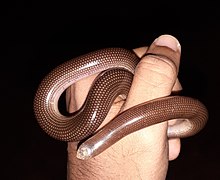Grypotyphlops acutus: Difference between revisions
m Task 18 (cosmetic): eval 1 template: hyphenate params (1×); |
m fixed lint errors – missing end tag |
||
| (7 intermediate revisions by 5 users not shown) | |||
| Line 1: | Line 1: | ||
{{Short description|Species of snake}} |
|||
{{Speciesbox |
{{Speciesbox |
||
| |
| name = Beaked blind snake |
||
| image = Grypotyphlops acutus 123806704.jpg |
|||
| status = LC |
|||
| status_system = IUCN3.1 |
| status_system = IUCN3.1 |
||
| status_ref = <ref name= |
| status_ref = <ref name="iucn status 20 November 2021">{{cite iucn |author=Srinivasulu, B. |author2=Srinivasulu, C. |author3=Vijayakumar, S.P. |author4=Ganesan, S.R. |author5=Madala, M. |date=2013 |title=''Grypotyphlops acutus'' |volume=2013 |page=e.T172598A1349131 |doi=10.2305/IUCN.UK.2013-1.RLTS.T172598A1349131.en |access-date=20 November 2021}}</ref> |
||
| genus = Grypotyphlops |
| genus = Grypotyphlops |
||
| parent_authority = [[Wilhelm Peters|Peters]], 1881 |
| parent_authority = [[Wilhelm Peters|Peters]], 1881 |
||
| Line 11: | Line 14: | ||
* ''Onychocephalus westermanni'' [[Christian Frederik Lütken|Lütken]], 1862 |
* ''Onychocephalus westermanni'' [[Christian Frederik Lütken|Lütken]], 1862 |
||
* ''Onychocephalus acutus'' <br/>- [[Albert Günther|Günther]], 1864 |
* ''Onychocephalus acutus'' <br/>- [[Albert Günther|Günther]], 1864 |
||
* ''T''[''yphlops'']. excipiens'' [[Giorgio Jan|Jan]] ''In'' [[Giorgio Jan|Jan]] & Sordelli, 1865 |
* ''T''[''yphlops'']. ''excipiens'' [[Giorgio Jan|Jan]] ''In'' [[Giorgio Jan|Jan]] & Sordelli, 1865 |
||
* ''Onychocephalus malabaricus'' [[Richard Henry Beddome|Beddome]] ''In'' [[Albert Günther|Günther]], 1875 |
* ''Onychocephalus malabaricus'' [[Richard Henry Beddome|Beddome]] ''In'' [[Albert Günther|Günther]], 1875 |
||
* ''Gr''[''ypotyphlops'']. ''acutus'' <br/>- [[Wilhelm Peters|Peters]], 1881 |
* ''Gr''[''ypotyphlops'']. ''acutus'' <br/>- [[Wilhelm Peters|Peters]], 1881 |
||
| Line 26: | Line 29: | ||
}} |
}} |
||
'''''Grypotyphlops acutus''''', also known as the '''beaked worm snake''', '''beaked blind snake''', or '''beak-nosed worm snake''', is a harmless [[Typhlopidae|blind snake]] [[species]] [[Endemism|endemic]] to peninsular [[India]]. No [[subspecies]] are currently recognized.<ref name=RDB/> |
'''''Grypotyphlops acutus''''', also known as the '''beaked worm snake''', '''beaked blind snake''', or '''beak-nosed worm snake''', is a harmless [[Typhlopidae|blind snake]] [[species]] [[Endemism|endemic]] to peninsular [[India]]. It is the only species in the genus '''''Grypotyphlops'''''. No [[subspecies]] are currently recognized.<ref name=RDB/> |
||
== Taxonomy == |
|||
''Grypotyphlops'' is thought to group with the [[Africa|African]] [[Typhlopidae|typhlopids]] in the genera ''[[Afrotyphlops]]'', ''[[Letheobia]]'', and ''[[Rhinotyphlops]]'', being the [[sister group]] to the latter two and having dispersed from Africa to the [[Indian subcontinent]] during the [[Paleogene]]. This contrasts with the other blind snakes in the Indian subcontinent, which are thought to have either mainland Asian ancestry (''[[Indotyphlops]]'' and ''[[Argyrophis]]'') or be descended from ancient [[Gondwana|Gondwanan]] endemics of [[Insular India]] (''[[Gerrhopilus]]'').<ref>{{Cite journal |last1=Sidharthan |first1=Chinta |last2=Karanth |first2=K. Praveen |date=2021-04-01 |title=India's biogeographic history through the eyes of blindsnakes- filling the gaps in the global typhlopoid phylogeny |url=https://www.sciencedirect.com/science/article/pii/S1055790320303365 |journal=Molecular Phylogenetics and Evolution |language=en |volume=157 |pages=107064 |doi=10.1016/j.ympev.2020.107064 |pmid=33387646 |s2cid=230282291 |issn=1055-7903}}</ref> |
|||
==Geographic range== |
==Geographic range== |
||
This species is found throughout peninsular India south of the [[Ganges]] and [[Rajputana]] basins. The [[Type locality (biology)|type locality]] given is "''inconnue''" ([[French language|French]] for unknown).<ref name="McD99"/> |
|||
==References== |
==References== |
||
Latest revision as of 11:26, 11 December 2023
| Beaked blind snake | |
|---|---|

| |
| Scientific classification | |
| Domain: | Eukaryota |
| Kingdom: | Animalia |
| Phylum: | Chordata |
| Class: | Reptilia |
| Order: | Squamata |
| Suborder: | Serpentes |
| Family: | Typhlopidae |
| Genus: | Grypotyphlops Peters, 1881 |
| Species: | G. acutus
|
| Binomial name | |
| Grypotyphlops acutus (A.M.C. Duméril & Bibron, 1844)
| |
| Synonyms | |
| |
Grypotyphlops acutus, also known as the beaked worm snake, beaked blind snake, or beak-nosed worm snake, is a harmless blind snake species endemic to peninsular India. It is the only species in the genus Grypotyphlops. No subspecies are currently recognized.[3]
Taxonomy[edit]
Grypotyphlops is thought to group with the African typhlopids in the genera Afrotyphlops, Letheobia, and Rhinotyphlops, being the sister group to the latter two and having dispersed from Africa to the Indian subcontinent during the Paleogene. This contrasts with the other blind snakes in the Indian subcontinent, which are thought to have either mainland Asian ancestry (Indotyphlops and Argyrophis) or be descended from ancient Gondwanan endemics of Insular India (Gerrhopilus).[4]
Geographic range[edit]
This species is found throughout peninsular India south of the Ganges and Rajputana basins. The type locality given is "inconnue" (French for unknown).[2]
References[edit]
- ^ Srinivasulu, B.; Srinivasulu, C.; Vijayakumar, S.P.; Ganesan, S.R.; Madala, M. (2013). "Grypotyphlops acutus". IUCN Red List of Threatened Species. 2013: e.T172598A1349131. doi:10.2305/IUCN.UK.2013-1.RLTS.T172598A1349131.en. Retrieved 20 November 2021.
- ^ a b McDiarmid RW, Campbell JA, Touré T. 1999. Snake Species of the World: A Taxonomic and Geographic Reference, vol. 1. Herpetologists' League. 511 pp. ISBN 1-893777-00-6 (series). ISBN 1-893777-01-4 (volume).
- ^ a b Grypotyphlops acutus at the Reptarium.cz Reptile Database. Accessed 13 February 2020.
- ^ Sidharthan, Chinta; Karanth, K. Praveen (2021-04-01). "India's biogeographic history through the eyes of blindsnakes- filling the gaps in the global typhlopoid phylogeny". Molecular Phylogenetics and Evolution. 157: 107064. doi:10.1016/j.ympev.2020.107064. ISSN 1055-7903. PMID 33387646. S2CID 230282291.
Further reading[edit]
- Boulenger, G.A. 1890. The Fauna of British India, Including Ceylon and Burma. Reptilia and Batrachia. Taylor & Francis, London, xviii, 541 pp.
- Duméril, A.M.C. & Bibron, G. 1844. Erpetologie Générale ou Histoire Naturelle Complete des Reptiles. Vol.6. Libr. Encyclopédique Roret, Paris.
- Wallach, Van 1994. The status of the Indian endemic Typhlops acutus (Duméril and Bibron) and the identity of Typhlops psittacus Werner (Reptilia, Serpentes, Typhlopidae). Bulletin de l'Institut Royal des Sciences Naturelles de Belgique Biologie. Vol. 64, pp. 209–229.

